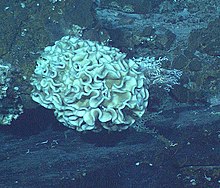This article may be too technical for most readers to understand. (June 2023) |
"Monothalamea" is a grouping of foraminiferans, traditionally consisting of all foraminifera with single-chambered tests. Recent work has shown that the grouping is paraphyletic, and as such does not constitute a natural group; nonetheless, the name "monothalamea" continues to be used by foraminifera workers out of convenience.[4]
| Monothalamea | |
|---|---|

| |
| Image of a deep sea xenophyophore | |
| Scientific classification | |
| Domain: | Eukaryota |
| Clade: | Diaphoretickes |
| Clade: | SAR |
| Phylum: | Retaria |
| Subphylum: | Foraminifera |
| Class: | Monothalamea Haeckel, 1862,[1] emend. Pawlowski et al., 2013[2] |
| Orders and subtaxa incertae sedis[3] | |
| |
Classification
edit"Monothalamea" traditionally contains two groups, neither of which is currently considered to be monophyletic:
- "Allogromiida" traditionally consists of all foraminifera which lack a mineralised test, instead having a test of tectin. Recent work has shown that this grouping is paraphyletic.
- "Astrorhizida" traditionally consists of all foraminifera with single-chambered, agglutinated tests. Recent work has shown that this grouping is polyphyletic, as agglutinated tests have evolved from proteinaceous tests multiple times throughout foraminiferal evolution.[4]
Recent molecular evidence has revealed that the deep-sea xenophyophores are in fact agglutinated, single-chambered foraminifera.[5] Molecular evidence has also revealed that the freshwater protist Reticulomyxa is in fact a naked, testless foraminifera, and as such it has been included with "monothalameans" in scientific discussion.[4][6]
A 2013 molecular study using small subunit rDNA concluded that known "monothalameans" made up at least 22 distinct living clades from marine environments with an additional four clades from freshwater eDNA.[4]
References
edit- ^ Ernst Haeckel: Die Radiolarien (Rhizopoda Radiaria). Berlin, 1862
- ^ Pawlowski, Jan; Holzmann, Maria; Tyszka, Jarosław (March 2013). "New supraordinal classification of Foraminifera: Molecules meet morphology" (PDF). Marine Micropaleontology. 100: 1–10. Bibcode:2013MarMP.100....1P. doi:10.1016/j.marmicro.2013.04.002. Retrieved 7 January 2019.
- ^ Hayward, B.W.; Le Coze, F.; Gross, O. (2019). World Foraminifera Database. Monothalamea. Accessed through: World Register of Marine Species at: http://www.marinespecies.org/aphia.php?p=taxdetails&id=744106 on 2019-01-07
- ^ a b c d Pawlowski, Jan; Holzmann, Maria; Tyszka, Jarosław (2013-04-01). "New supraordinal classification of Foraminifera: Molecules meet morphology". Marine Micropaleontology. 100: 1–10. Bibcode:2013MarMP.100....1P. doi:10.1016/j.marmicro.2013.04.002. ISSN 0377-8398.
- ^ Pawlowski, Jan; Holzmann, Maria; Fahrni, Jose; Richardson, Susan L. (2003). "Small Subunit Ribosomal DNA Suggests that the Xenophyophorean Syringammina corbicula1 is a Foraminiferan". Journal of Eukaryotic Microbiology. 50 (6): 483–487. doi:10.1111/j.1550-7408.2003.tb00275.x. ISSN 1550-7408. PMID 14733441. S2CID 39906626.
- ^ Pawlowski, Jan; Bolivar, Ignacio; Fahrni, Jose F.; Vargas, Colomban De; Bowser, Samuel S. (1999). "Molecular Evidence That Reticulomyxa Filosa Is A Freshwater Naked Foraminifer". Journal of Eukaryotic Microbiology. 46 (6): 612–617. doi:10.1111/j.1550-7408.1999.tb05137.x. ISSN 1550-7408. PMID 10568034. S2CID 36497475.
Further reading
edit- Gubbay, S., Baker, M., Bettn, B., Konnecker, G. (2002). "The offshore directory: Review of a selection of habitats, communities and species of the north-east Atlantic", pp. 74–77.
- NOAA Ocean Explorer. "Windows to the deep exploration: Giants of the protozoa", p. 2.